Do you love cosplay, manga, anime, fandom memorabilia, and toys? Perhaps the center of your fandom universe lies in Tokyo, Japan. If so, you probably identify as Otaku. If you are otaku, or can relate to it, then I have the book for you! If you aren't into otaku culture yet, you soon will be, after reading Tokyo Geek's Guide: Manga, Anime, Gaming, Cosplay, Toys, Idols, & More, by Gianni Simone. Be forewarned: I LOVE THIS BOOK.
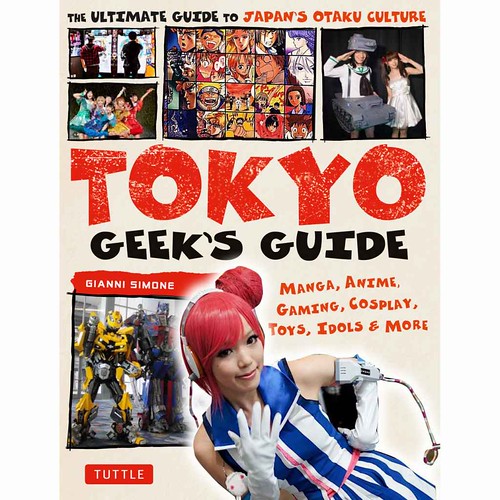
"Tokyo is ground zero for Japan's popular "geek" (otaku) culture - a phenomenon that has now swept across the globe. This is the most comprehensive guide ever produced to Tokyo's geeky underworld. It provides a comprehensive run-down on each majoy Tokyo district where geeks congregate, shop, play, and hang out - from hi-tech Akihabara and trendy Harajuku, to newer and lesser-known haunts like chic Shimo-kita and working-class Ikebukuro."
What Simone has created is marvelous - his Tokyo Geek's Guide is the best guidebook I've ever read. He's an author that wears many hats in this book - travel guide, translator, sparker of interest, photographer, fan, wiki, a guide to Japanese language and culture, and otaku. When you combine all this expertise into one book, that book is a shining lodestar for fans of otaku culture. Reading it is like coming home - and finding a slew of new cousins had moved in. You're simultaneously delighted, intrigued, and want to stay up all night talking, discovering, laughing.
Here's what I love about this book:
* It clearly explains the many aspects of otaku fandom
* It's a complete travel guide to many areas of Tokyo that are unusual, hard to discover, and often not in English
* Delving deeply into each neighborhood, the book gives clear directions, information, and inspiration
* The photos are inspirational - not only for traveling to and around Tokyo, but to up your otaku game
* Don't know what to do, how to order, how to play, or other cultural norms and mores? Simone has outlined everything so clearly that you feel comfortable in a new place - even calling it your own, once you've got it down
* It helps you find your tribe - even if that tribe is halfway around the world
As you may surmise, highly recommended.
We were lucky enough to catch up with Simone, and ask him about the book, inspiration, interest in otaku culture, the joys and challenges of research, and more. Here's what he had to say:
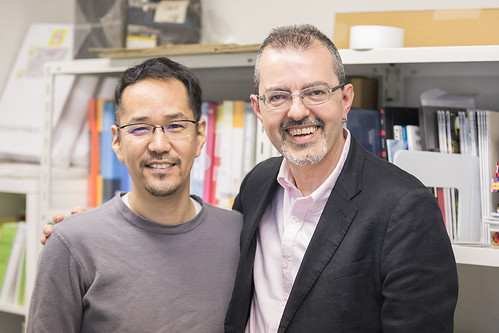
Gianni Simone and "Napping Princess" director Kenji Kamiyama. Photo: Benjamin Parks
Please tell us about your book, Tokyo Geek's Guide...
This is an otaku guide to Tokyo. I tried to cover every side of otaku fandom as well as I could. The first chapter briefly introduces each of the six main otaku genres (manga, anime, video games, toys, cosplay, and idols) from a historical perspective. It provides a few tidbits of trivia and cultural insight (e.g., how Akihabara evolved from a hub for radio enthusiasts to the modern-day gamer haven it has become) while highlighting Japan's influence abroad and trying to point out how each genre may evolve in the future.
This is followed by the book's main, travel guide part. In each chapter (devoted to one of Tokyo's major otaku areas) I show interesting things to see and do – not only things to buy but anime-related spots, cosplay and other otaku events, manga museums, and libraries. The main difference from your typical travel book is that I actually guide the reader on a walk through each area in a sort of geeky urban exploration.
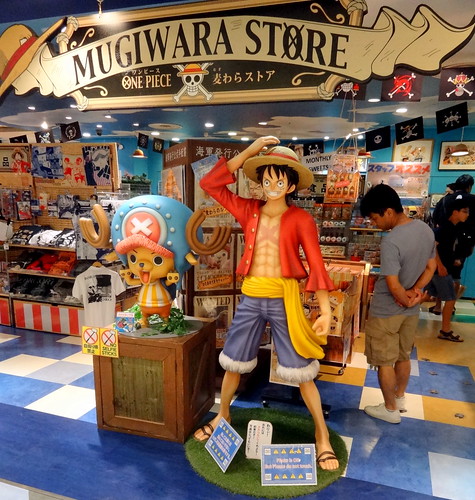
One Piece Mugiwara Store in Shibuya
What inspired you to write this book?
This project was born from my personal need to find otaku-related information. While there are hundreds of general travel guides on the market – some of them covering very specialized subjects – I discovered that nobody had ever covered Tokyo from an otaku point of view. There are many people who are more knowledgeable than me, but they apparently prefer to dig deeper and pen books on manga philosophy or the moe concept. Entry-level otaku and people who just want to explore Tokyo are left with surfing the Internet for information. Of course, now you can find a lot of things online, but the Internet can be very dispersive and unreliable. Also, a lot of important information is still only available in Japanese. So I decided to gather all these loose ends and put them together in book form.
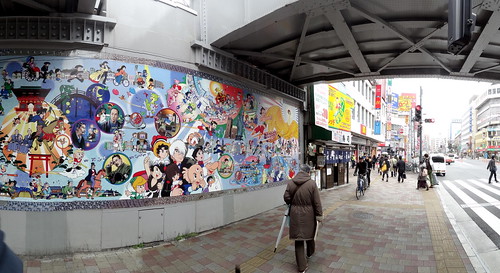
Tezuka Productions mural in Takadanobaba, Tokyo
What is your background (and beginning interest) in otaku culture?
I belong to the very first generation of European anime fans. The first Japanese TV series (Grendizer, Mazinger Z, Heidi, etc.) appeared in France and Italy (my home country) back in the summer of 1978, when I was in junior high school. I still remember my shock the first time I saw those alien-looking sci-fi anime that were seemingly coming from another planet. At the time, my family used to have dinner in our kitchen which doubled as a dining room. But our TV was in the living room, and Grendizer (Goldrake, as it was called in Italy) was broadcasted at dinner time. So my parents (bless them) let me eat my food alone in the living room.
What might readers be surprised to learn about otaku culture, and general geekdom in Tokyo?
What a trip to Tokyo really makes apparent is how much otaku "sights and sounds" are part of Japanese life, from giant billboards and graffiti to the jingles in some train stations. Manga- and anime-inspired imagery is so pervasive it can literally be found everywhere and is used to sell products, as well as advise people on socially sensitive issues.
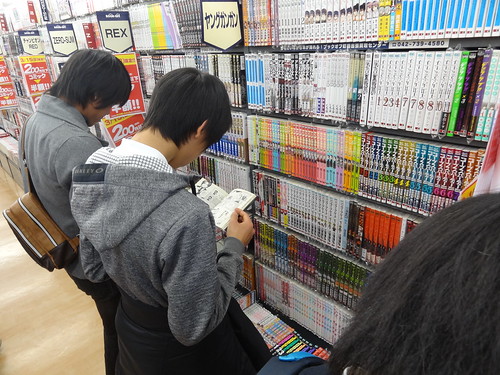
Fans spend hours reading their favorite manga in bookstores... without buying them
Another thing worth noting is how few concessions Akihabara and other otaku districts make to mainstream western tastes. Though local shops welcome the growing number of foreign customers, many if not most of the things they sell are for local hardcore fans, which means you will probably discover many things you have never seen—which is not necessarily a bad thing. Even as far as Western pop culture is concerned, there is precious little to be found except what the Japanese themselves like (i.e., Star Wars and Disney).
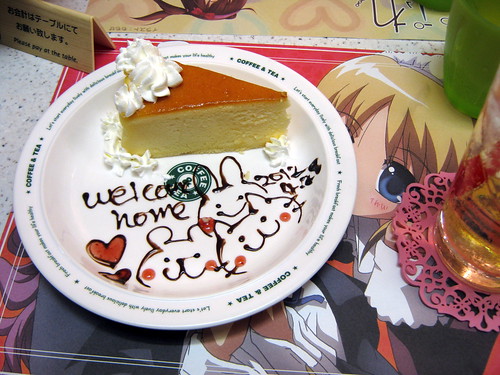
Maid cafe food. Photo: La Japonie Facile
We're all about the research - what were the joys and challenges of finding SO many cool things that you've included in this book?
I would say for many writers the planning stage (when the book slowly takes shape) and the actual research are the most interesting parts. The writing itself, in comparison, is a sort of anticlimax (George Orwell famously went so far as to say that writing a book can be "a horrible, exhausting struggle"). For me, researching the book was like going on a sort of treasure hunt, so it was a lot of fun. This said, dealing with Japanese red tape can be exhausting. For each copyrighted image I wanted to use in my book, I had to exchange endless mails with companies, museums, etc. Luckily, my Japanese wife helped me navigate this Kafkaesque maze.
What's up next for you?
The Tokyo Geek's Guide has gathered a lot of positive feedback, so I'm already working on another otaku-related project. However, geek culture is not my only interest, and I hope to be able to publish a different kind of book in the near future; a sort of oral history of Tokyo based on my journalistic work.
Is there anything else you'd like to share?
I have recently launched a companion blog to my book, called Otaku Tokyo. Also, I'm a regular contributor to Zoom Japan magazine (let's say I'm their main Man in Japan). Anybody who is interested in all things Japan should definitely check out our website: www.zoomjapan.info. Last but not least, if readers of my book have any feedback to share (either good or bad) they can reach me at bero_berto[at]yahoo.co.jp.
All photos courtesy and copyright Gianni Simone, except where noted
